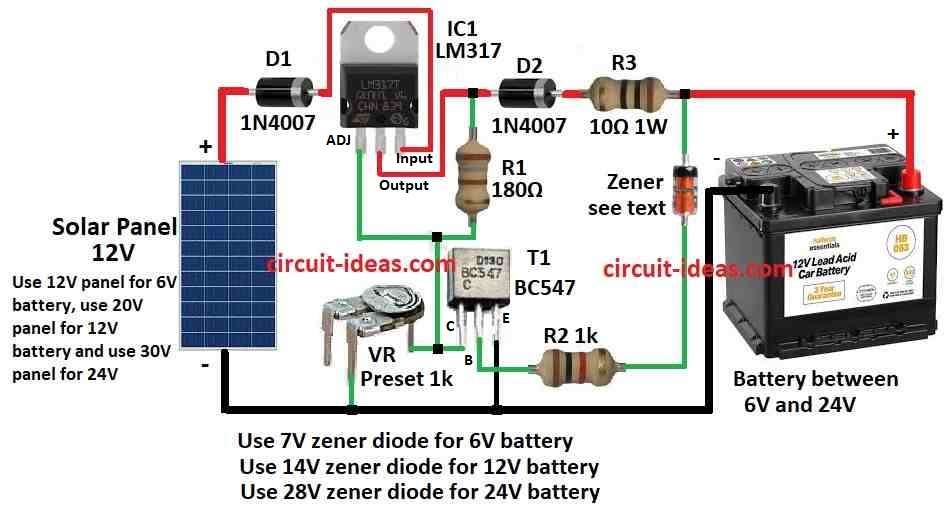LM317 IC Solar Charger Circuit with Auto Cut off works like smart nanny for a battery.
It takes sunlight and charge battery but stop at right time.
Inside it have one smart chip called LM317 which control charging and gives battery only needed power which is not too much.
Best thing is it also have safety part inside like when battery is full it cut off the charging by itself so the battery is not overcharge or damage.
One should just sit back, relax and enjoy solar power for its own use.
Circuit Working:

Parts List:
| Category | Component | Quantity |
|---|---|---|
| Resistors (All resistors are 1/4 watt unless specified) | 180Ω | 1 |
| 1k | 1 | |
| 10Ω 1W | 1 | |
| Preset 1k | 1 | |
| Semiconductors | IC LM317 | 1 |
| Transistor BC547 | 1 | |
| Zener diode (as shown in diagram) | 1 | |
| Diodes 1N4007 | 2 | |
| Solar Panel (as shown in diagram) | 1 | |
| Battery 6V to 24V | 1 |
This circuit makes solar charger to charge Lead Acid or Ni-Cd battery using sun power.
It uses solar energy smartly to charge 6V, 12V or 24V battery which are good for many things.
Charger have voltage and current control which also protect from too much voltage.
It uses solar panel for 6V, 12V or 24V and one adjustable chip called LM317.
Charging current go through diode D1 into LM317 chip.
We can change output voltage and current by adjusting adjust pin of LM317.
One variable resistor VR is put between adjust pin and ground that makes output around 9V to charge battery.
Resistor R3 stop too much current and diode D2 stop battery from losing power backward.
One transistor T1 and Zener diode work together to stop charging when battery is full.
Normally T1 stay OFF so battery keep getting charge.
But when battery voltage go more than Zener diode value then Zener start working and send current to T1.
Then T1 turns ON and connect LM317 output to ground and so the charging stops.
Formula:
Below is simple diagram and formula for LM317 solar charger with auto cut off.
LM317 Voltage Setup:
LM317 work as voltage controller when setup like this.
Output voltage (Vout) can be found by this formula:
Vout = Vref × (1 + R2 / R1) + Iadj × R2
where:
- Vref is fixed voltage of LM317which is about 1.25V
- R1 and R2 are resistors in divider setup
- Iadj is small current from adjust pin from around 50 microamps
Note:
With this simple diagram and formula one can start building its own LM317 solar charger with auto cut off which is based on what battery or setup is needed.
One just need to change the values as per its use.
How to Build:
To build an LM317 IC Solar Charger Circuit with Auto Cut off follow these below steps:
- Place LM317 IC on breadboard.
- Connect pin 3 input to + positive of solar panel.
- Connect pin 2 output to + positive of battery.
- Connect pin 1 adjust to resistor setup.
- Connect 180 ohm resistor from pin 1 adjust to pin 2 output.
- Connect 1k resistor from base of transistor T1 to + positive through Zener diode.
- Connect collector of transistor to pin 2 output of LM317.
- Connect emitter of transistor to ground.
- Connect base of transistor to Zener diode.
- Connect the other side of Zener to ground.
- Put diode D1 1N4007 between solar panel + positive and LM317 input to stop reverse current.
- Put diode D2 1N4007 between battery + positive and LM317 output to stop reverse current.
- Connect – negative of solar panel and battery both to ground.
Test the Circuit:
- Put solar panel in sunlight and see if battery is charging.
- Watch transistor and Zener and when battery is full they should stop charging.
Finish the Circuit:
- If all is working fine build it on PCB or make it more permanent.
Note:
- Be careful when working with circuits.
- Use safety glasses and check of any short circuits please.
Conclusion:
LM317 IC Solar Charger Circuit with Auto Cut off is smart and easy way to charge Lead Acid or Ni-Cd batteries using sunlight.
It use LM317 chip to control voltage and current and also stop charging when battery is full so there wont be any overcharge.
With right parts and setup this circuit is cheap and good for environment.
One can use it in many solar charging projects.
Leave a Reply